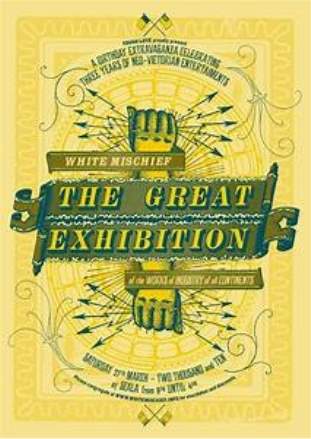Victorian and Edwardian Era: Social, Historical and Cultural Contexts
| ✅ Paper Type: Free Essay | ✅ Subject: History |
| ✅ Wordcount: 5220 words | ✅ Published: 23 Sep 2019 |
Contextual Studies
The purpose of this investigation is to identify key social, historical and cultural contexts within the Victorian and Edwardian era. In order to provide the reader with a realistic overview of this time, we will investigate different cultural contexts, trends and their influencers. This will include cultural influences, political factors and product availability. It will also include information about cultural difficulties and it will discuss societal factors. This information will be used to discuss how the hair and makeup culture was influenced, at that time. The writing will be a compiled list of research, which will be gathered from a range of credible sources. Sources such as books, websites and journals will be used to enhance the knowledge of this era and to generate information. From this research, an image/person will be chosen and will be created into a real-life model for the remaining study. The eras specifically researched will be the Victorian era, which runs from 1837 to 1901. In addition, we will research the Edwardian era which runs from 1901-1910.
In the era when Britain emerged as one of the most powerful nations to trade in the world, it was Queen Victoria that took her reign as queen throughout the decade (Matthews, 2008).
Throughout the Victorian and Edwardian period, women developed a style influenced by Queen Victoria. (Victoria , 2016) The heavy white make-up and bright roses of the last century were a thing of the past throughout these eras. Attitude towards make-up in the 18th and 19th century was more known to be negative than positive. Queen Victoria herself, thought heavily painted faces and bright make-up was vulgar and more suited for actresses and prostitutes. The look throughout the decade was mainly more subtle with a pale complexion, the pale complexion and fragile look was a sign of nobility. Thus, giving the impression that you were well off and did not need 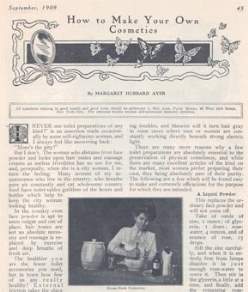 to work outdoors. (Matthews, 2008)
to work outdoors. (Matthews, 2008)
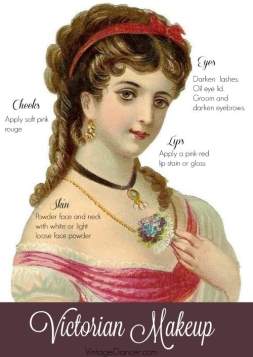
In order to achieve their pale complexion, women would use products such as zinc powder or bismuth blended with chalk or carbonate of lime. This, of course, depended on how much money you had. The most advertised brands available at that time were Saunders face powder. This product was available in pure white shades and in a more delicate roseate hue to impart a pleasing and healthful appearance. (Komar, 2016)
Starch was also another very popular ingredient in making Victorian facial powders, as you could also mix this with all this powder with essential oils to create a perfumed powder. (Fleming, 2012)
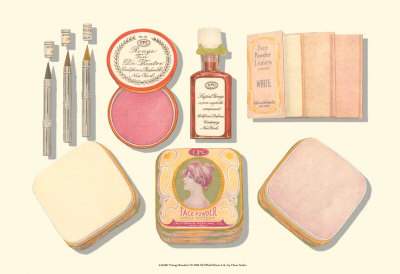 This powder was known as violet powder, this product was one of the least harmful cosmetics. Perfumed face powders were tinted with the shade of delicate pink or rose flesh coloured powders, which created an effect which was not too far from a modern-day foundation. Despite there being quite a negative stigma concerning cosmetics, Victorian women liked to add a subtle colour to their pale complexion. This was known as cheek and lip rouge. Cheek rouge added a rosy complexion, bringing colour to the cheeks. This was applied with the hairs foot or a Swans down puff. Upper-class women could afford to buy popular cosmetics and would have used one of the most popular brands of the 18th and 19th century, which
This powder was known as violet powder, this product was one of the least harmful cosmetics. Perfumed face powders were tinted with the shade of delicate pink or rose flesh coloured powders, which created an effect which was not too far from a modern-day foundation. Despite there being quite a negative stigma concerning cosmetics, Victorian women liked to add a subtle colour to their pale complexion. This was known as cheek and lip rouge. Cheek rouge added a rosy complexion, bringing colour to the cheeks. This was applied with the hairs foot or a Swans down puff. Upper-class women could afford to buy popular cosmetics and would have used one of the most popular brands of the 18th and 19th century, which
was known as Circassian bloom (shown in Figure 4). Even though the rouge was subtly applied the product was viewed as vulgar by some publications do to the fact the cheeks portrayed a look for women that showed excessive drinking. (Beautiful with Brains, 2010)
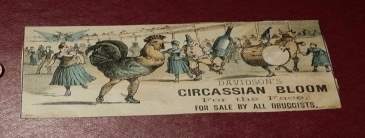
Towards the late 18th century, the attitude towards cosmetics started to change, this was mainly down to popular actresses at the time such as Sarah Bernhardt she inspired women to wear more make up in public due to her own beauty routine. In the year of 1909, Gordon Selfridge in Oxford Street, London, instigated placing cosmetics on counters, inspiring women to attempt to apply cosmetics before buying them. Before you knew it, beauty counters, like we know and use today, were born and very soon, additional shops followed suit. (Matthews, 2008) (Beautiful with Brains, 2010)
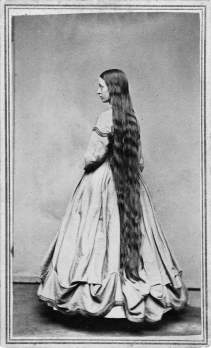 Victorian and Edwardian hair
Victorian and Edwardian hair
 As we start with the Victorian style, womens hair in this period was often thought to be one of her most respected possessions and assets. The overall style was wide-ranging quite a bit throughout times of Queen Victoria’s reign, from simple middle partings to intricate pieces made from human hair being in style. Bonnets, Combs, pearls used as accessories, each had their spell in the attention throughout the 1800s. Hair was long in the Victorian age. Tremendously long, as shown in Figure 5. Cuts were not precisely a thing yet for women. They did infrequently trim their split ends but long hair was regarded as being ultra-feminine and a much more desirable look.
As we start with the Victorian style, womens hair in this period was often thought to be one of her most respected possessions and assets. The overall style was wide-ranging quite a bit throughout times of Queen Victoria’s reign, from simple middle partings to intricate pieces made from human hair being in style. Bonnets, Combs, pearls used as accessories, each had their spell in the attention throughout the 1800s. Hair was long in the Victorian age. Tremendously long, as shown in Figure 5. Cuts were not precisely a thing yet for women. They did infrequently trim their split ends but long hair was regarded as being ultra-feminine and a much more desirable look.
Edwardian hairstyles tended to be a soft fluffy look, with a loose fluidity about them even though the hairstyle mainly consisted of being large and often padded to create the bulk and size fashionable during this period. Quite often fuzzy, especially if Marcel tongs were used on a regular occasion. The style was dressed actively away from the face, with a curled fringe which was seated on the forehead.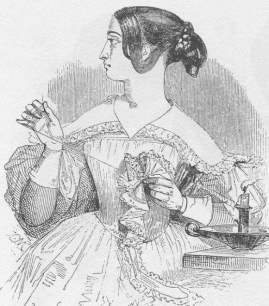 The crucial hairstyle for the Edwardian women was the pompadour.
The crucial hairstyle for the Edwardian women was the pompadour.
The shape of a pompadour is a high, rounded and curved away from the head. The pompadour could be dressed in a variety of styles, it could be straight or have a or be curled. It could be simply brushed up within a bun, softly curled coils, chignons and fuzzy fringes.
(Matthews, 2008) (Beautiful with Brains, 2010) (Boardman, 2001) (Downing, 2012) (H&MUA Team, 2012)

Throughout the Victorian and Edwardian period, society was divided into three classes – the upper class, the middle class and the lower class. The upper-class society were wealthier than of the other classes and mainly consisted of aristocrats, nobles, dukes, the royal family luxury’s attending tea parties and balls. Queen Victoria was a big influence during the Victorian era for women, and for the more wealthier ahistorical, could afford to look more refined women who could afford this look class could also afford to buy makeup products from manufacturars such as circassian bloom wich was very popular at the time, instead of combining substances to make make them.
The style we can see from images of the upper class women such as
fine fabrics, dignified dresses, bonnets and petticoats corsets. They
would be lavish expensive, made to impress but also came with many
subtle reminders of the upper class woman’s place. It was at this point in the 19th century that women’s clothes in the upper classes started to be
more sexualized. Women’s clothing exaggerated the hips, breasts and
derriere not only to make them seem more attractive, but to separate
these wealthy ladies from the world of work.
Middle class women may have been less rich as their nobles, but still
tried to mix in upper class circles. Women belonging to the middle class
were still expected to take education, acquire to help in the family
business and try and marry into a wealthier association.
As we come to the lower classes, the demise of the classes starts to
really show as extreme poverty and hygiene was rife. Women were
forced to take jobs such as prostitution, labouring or any activity that
involves physical strain. As a result, the style of these women was more
practical, hard wearing and generally worn. Hair was rarely washed and lice was more widespread. (Beautiful with Brains, 2010) (Boardman, 2001) (Fleming, 2012) (Komar, 2016)
Key female icons of the 18th century
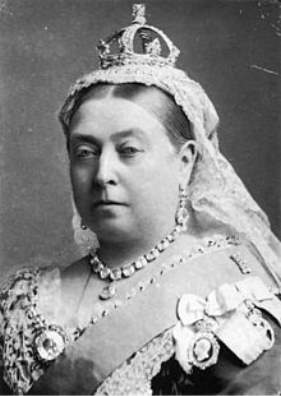
Key icons during this historical period include such women as Elizabeth Gaskell, Queen Victoria, Elizabeth Garrett Anderson and Emmeline Pankhurst.
Queen Victoria was a very influential lady, not only in her aristocracy as queen but with Victorian women alike for her style and porcelain skin she paved the way for the less is more make up look of the 18th century with pale complexion. She was also a keen activist of the British Empire. She celebrated and supported British involvement in the Boer War. Also her dignified involvement to preside over the growth of the British Empire, which was to reach across the globe. Although her popularity dipped during her time as queen towards the end of the 18th century, she became an outstanding royal for pride and British realism.
(Pettinger, 2014) (Victoria , 2016)
Elizabeth Gaskell
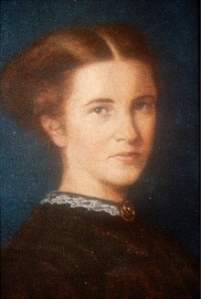 Elizabeth Gaskell (shown in Figure 10) was a powerful female novelist. Her publication of Mary Bartons tale of Manchester life identifies the social classes at the time and was critically frowned upon for her sympathy towards the lower class workers and their treatment from there masters. Her honesty and observation in her books growing up in Victorian Britain critically acclaimed her as one of the most inspiring females at the period. (North & South, 2004) (BBC, 2014)
Elizabeth Gaskell (shown in Figure 10) was a powerful female novelist. Her publication of Mary Bartons tale of Manchester life identifies the social classes at the time and was critically frowned upon for her sympathy towards the lower class workers and their treatment from there masters. Her honesty and observation in her books growing up in Victorian Britain critically acclaimed her as one of the most inspiring females at the period. (North & South, 2004) (BBC, 2014)
Icons 2
Elizabeth Garrett Anderson
Elizabeth Garrett Anderson (shown in Figure 11) was the first women of medicine to qualify in England. She opened a school for women to practise medicine and gallantly paved the way for women’s medical education in Britain. Born in Whitechapel, London, a sibling of 12 She was given a good standard of education and wanted to become a doctor after meeting a female practitioner Elizbeth Blackwell and being inspired. She  moved to the united states and became the first female doctor to graduate in the United States.
moved to the united states and became the first female doctor to graduate in the United States.
Emmeline Pankhurst
Emmeline Pankhurst (shown in Figure 12) was perhaps one of the most influential women of the 18th century and progressing into the Edwardian decade. Setting for the drive for change with how women were treated and, upon this, demanded women had the same rights as men. She was born on 14 July 1858 in Manchester. Her family were very wealthy, and both her parents were politically active. Growing up in the Victorian era, she began to notice how different women were treated to men and strived to change this. In the year 1903, she set up a union called the Women’s Social and Political Union (WSPU).
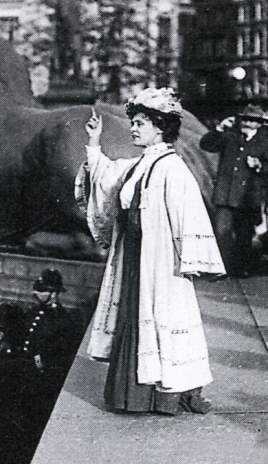
Emmeline Pankhurst was a innovator for women’s rights and remembered for her hard intensively hard work with the WSPU to help fight and give British women the right to vote.
The female silhouette 1850-1910
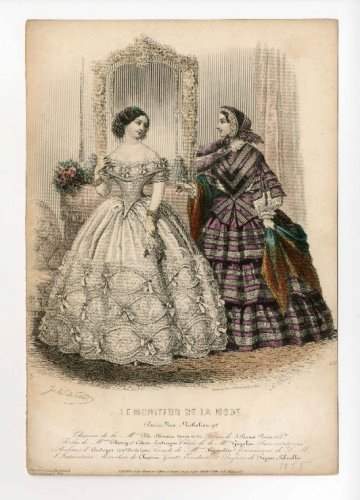 In the middle of the 18th century, the female silhouette was a very distinctive hourglass figure with small tightfitting waists and dome-shaped skirts which continue to grow ever larger. Women’s skirts would domed like a bell shape this and the corset, were very popular this portrayed a very dainty and feminine ideal on the most current and essential look through the mid-1850s. The crinoline was a petticoat this was typically made out of horse hair, material which held the gown from the Body skirts of this stature gives the waste an even smaller magnitude. An example is shown in Figure 13.
In the middle of the 18th century, the female silhouette was a very distinctive hourglass figure with small tightfitting waists and dome-shaped skirts which continue to grow ever larger. Women’s skirts would domed like a bell shape this and the corset, were very popular this portrayed a very dainty and feminine ideal on the most current and essential look through the mid-1850s. The crinoline was a petticoat this was typically made out of horse hair, material which held the gown from the Body skirts of this stature gives the waste an even smaller magnitude. An example is shown in Figure 13.
In 1865, the first signs of the change in silhouette were gradually starting to be more visible women became more active and additional gores were added to the skirts to provide better movement. Dresses were longer in the back. The goring because the lower part of the lady’s skirts to loosen the fashion of the dress hard perfect trains behind it this made the lock elegant for the drawing room but were not very practical for walking around the dirty streets. Examples are shwon in Figures 14 & 15.
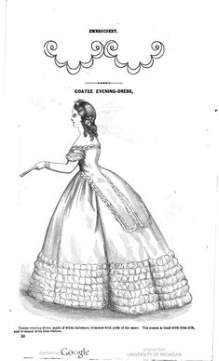
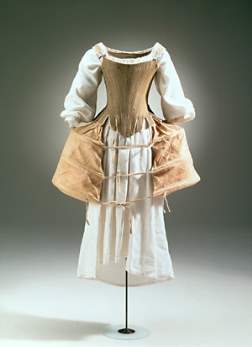
As we head towards the 1870’s, this cerise bodice was introduced the body’s were extended very tight around the hips dresses such as fashionable ballgowns were being made more around the front this new style of dress many Victorians seem to object as they considered this style of dress to be more sexualised. Almost comparing them to undergarments. By the late 1870’s, the skirts were designed so long that women started to wear false skirts underneath, tea gowns started to all be popular and women could weigh these without halving the agony of wearing tight corsets.
As we come to the end of the 1890’s, jackets and skirts were more masculine due to women becoming more active and this would allow more room. The tiny waist silhouette that remained through out this decade was even more enhanced with wearing a swiss belt and a figure hugging corselet, corselets unlike the standard corset style, were worn outside the clothing this look achieved a such a small waist that it is known that the average style waist at that time was a mere 22 inches. This is shown in Figure 16.
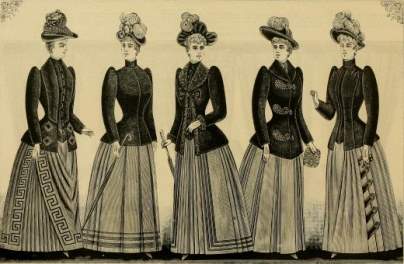
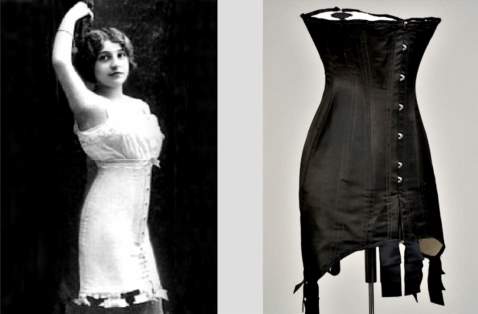 As we enter a new decade into the Edwardian era, the ‘s’ bend coreset was introduced (as shown in Figure 17) and started to become more popular than the previous style of Victorian wear. This type of garment propelled the hips backwards and the chest forwards creating a more pigeon shaped silhouette, this high wasted fashion stayed popular into 1910 but the ever changing silhouette continued to evolve as the years progressed in towards the middle of the Edwardian period. After the first world war Dresses started to become less fitted a more simplistic look was created and with that came more freedom. (Royal Albert Hall, 2018) (Matthews, 2008) (Vintage Fashion Guild, 2018)
As we enter a new decade into the Edwardian era, the ‘s’ bend coreset was introduced (as shown in Figure 17) and started to become more popular than the previous style of Victorian wear. This type of garment propelled the hips backwards and the chest forwards creating a more pigeon shaped silhouette, this high wasted fashion stayed popular into 1910 but the ever changing silhouette continued to evolve as the years progressed in towards the middle of the Edwardian period. After the first world war Dresses started to become less fitted a more simplistic look was created and with that came more freedom. (Royal Albert Hall, 2018) (Matthews, 2008) (Vintage Fashion Guild, 2018)
The great exhibition of 1851
In the middle of the 18th century, with queen Victoria and prince Albert firmly mapping their reign on Victorian society, things began to change. Not only for a new ideal but one of prosper and hope, especially for the middle class of the time new jobs and more work meant more exciting times ahead.
The great exhibition of 1851, set in London’s Knightsbridge, was the inspiration of prince Albert, this was to become one of the most historical events Britain had seen.
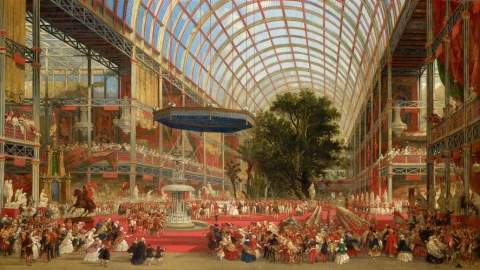
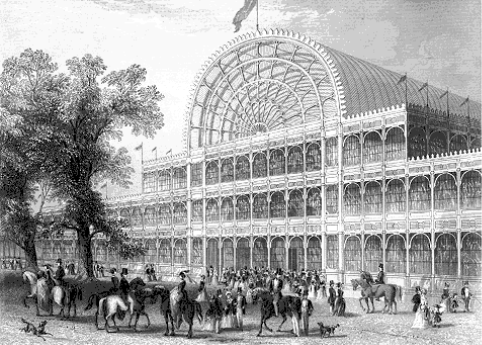
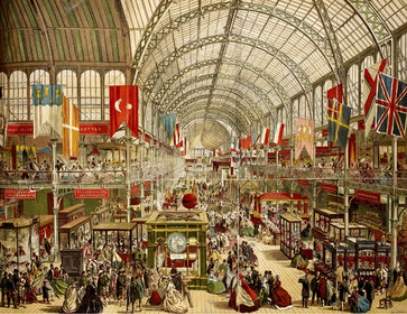 At that time, England was experiencing a manufacturing rise this set the scene for a great exhibition, for industry trades and of all nations to attend. After the industrial revolution Britain wanted the world to know their success, to show off and celebrate their new industrial design technology. There was a average of 15,000 contributors and a display of over 10,000 objects. The great exhibition was on a colossal platform, not just for technology but influential for art, education , international trade and tourism seen a massive increase. Housed within the crystal palace, this grand design and structure was a vast array of glass and cast iron was the brainchild of architect joseph Paxton who took his ideas for this spectacular building, came from the water Lilly Victoria, a lily that can support huge leaves. The crystal palace also featured fountains and waterfalls, the highest at 250 feet. From the time of May 1851 to October of 1851 its been accounted, that a figure of 6 million visitors passed through its doors and a profit of 186,000 pounds and not a loss as once thought predicated.
At that time, England was experiencing a manufacturing rise this set the scene for a great exhibition, for industry trades and of all nations to attend. After the industrial revolution Britain wanted the world to know their success, to show off and celebrate their new industrial design technology. There was a average of 15,000 contributors and a display of over 10,000 objects. The great exhibition was on a colossal platform, not just for technology but influential for art, education , international trade and tourism seen a massive increase. Housed within the crystal palace, this grand design and structure was a vast array of glass and cast iron was the brainchild of architect joseph Paxton who took his ideas for this spectacular building, came from the water Lilly Victoria, a lily that can support huge leaves. The crystal palace also featured fountains and waterfalls, the highest at 250 feet. From the time of May 1851 to October of 1851 its been accounted, that a figure of 6 million visitors passed through its doors and a profit of 186,000 pounds and not a loss as once thought predicated.
Visitors included factory workers sent by their employers, countrymen school children, the elite from around the world even queen Victoria herself was a frequent visitor. Travel agent Thomas cook made it affordable and possible for more people to visit the great exhibition by organising trains to London for one shilling.
(Picard, 2009)
The arts and crafts movement of the late 1800’s
Towards the late 1860’s and 1870’s, Britain needed a new approach towards architecture and design. In its preceding years, machine production was damaging both social conditions and the standard of manufacturing goods. The Arts and Crafts movement was produced out of an increasing and a desire to understand that as a nation and with in its society it needed to adopt a different adaptation of ideals in relation to the manufacturing of objects. It needed to develop products that not only had more honour, but which were also made in a decreased dehumanising way. Structured forwarded more by a set of ideals than a inflexible style, the movement took its name from the Arts and Crafts Exhibition Society, a group founded in London in 1887, by illustrator Walter Crane. The main objective of this was to show off the grand gesture of the artistic work in a more public form. (Grange, 2002)
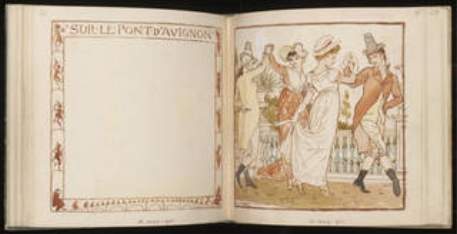
“Fine art is that in which the hand, the head, and the heart of man go together.” John Ruskin, ‘The Cestus of Aglaia, the Queen of the Air’, 1870.
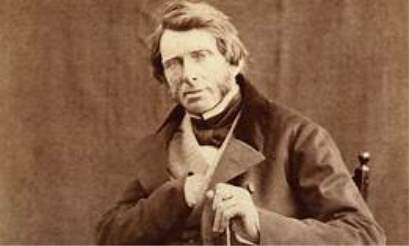
The idea of good design was linked to their notions of a better society. This outlet of a society in which the worker was not dehumanized by the appalling working conditions, that could be found in the factories of the late Victorian century, taking more pride in his technique and skill. The rise of a purchaser class coincided with the rise of manufactured consumer goods. the goal was to create design that was… ” for the people and by the people, and a source of pleasure to the maker and the user.” Workers could produce beautiful objects that would enhance the lives of ordinary people, and at the same time provide decent employment for their crafts.
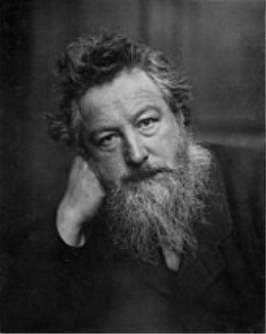
Famous designer’s such as John Ruskin and William Morris, were responsible for pioneering roles in the Gothic Revival style of architecture. Ruskin was the vigorous soul driving the Victorian Gothic Revival, a dynamic combination of religious evangelism and architectural dedication that overthrew two centuries of Renaissance classicism with pointed arches, stained glass and encaustic tiles. Today, Pugin’s work is being reviewed as designers learn once again to cope with colour and remarry architecture to the arts and crafts. To the public at large, however, he remains all but overlooked. William Morris was the most influential designer on the Arts and Crafts movement. The visual and social vision of the Arts and Crafts movement resulting from ideas he developed in the 1850s with a students at Oxford, who’s mutual love of Dreamy literature with a promise to social improvement (Glancey, 1994)
The Pre-Raphaelites
The pre-Raphaelites are among the best known of all English paintings, and yet they have sometimes been dismissed as Victoriana or sheer distraction. Directed by Dante Gabriel Rossetti, William Holman Hunt and John Everett Millais, the Pre-Raphaelites campaigned against the art formation of their day and were dedicated to the impression of art’s potential to change Victorian society.
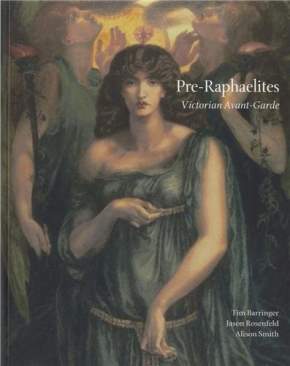
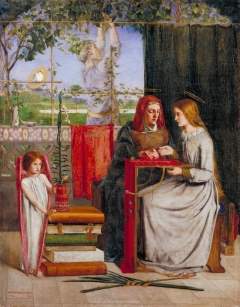 Their uncompromisingly fundamental style, stimulated by the purity of first renaissance painting, challenged settlement, incited criticisers and engrossed spectators. Numerous famous Pre-Raphaelite paintings are included, including Millais’ Ophelia and Maddox Brown’s The Last of England, composed with less accustomed works. In variation with preceding surveys, that important role of the Brotherhood that took part in the early expansion of the Arts and Crafts movement and the co-operative ideas of the designer, William Morris. They were also Inspired by the philosophies of John Ruskin, who advised artists to ‘go to nature’, they alleged in an art of sincere subjects treated with supreme practicality. Their major themes were initially devout, but they also used themes from literature and poetry, particularly those dealing with love and death. They also explored modern social problems.
Their uncompromisingly fundamental style, stimulated by the purity of first renaissance painting, challenged settlement, incited criticisers and engrossed spectators. Numerous famous Pre-Raphaelite paintings are included, including Millais’ Ophelia and Maddox Brown’s The Last of England, composed with less accustomed works. In variation with preceding surveys, that important role of the Brotherhood that took part in the early expansion of the Arts and Crafts movement and the co-operative ideas of the designer, William Morris. They were also Inspired by the philosophies of John Ruskin, who advised artists to ‘go to nature’, they alleged in an art of sincere subjects treated with supreme practicality. Their major themes were initially devout, but they also used themes from literature and poetry, particularly those dealing with love and death. They also explored modern social problems.
(Barringer, et al., 2012) (TATE, 2018)
Post impressionism& Art nevou
To describe Post-Impressionism, it is a term used to define the responses in the 1880s against Impressionism. Led by, Paul Gauguin, Vincent van Gogh ,Paul Cézanne and Georges Seurat. They disallowed Impressionism’s worry with the impulsive and naturalistic interpretation of light and colour. They preferred a symbolic content, official knowledge and structure. Comparable to the Impressionists, though they worried the inauthenticity of the picture. They also believed that colour could be independent from form, as an emotional carrier of meaning. Both Impressionism and Post, include some of the most well-known works of art such as van Gogh’s Starry Night. Impressionism and Post-Impressionism remain to be some of the most well-known and adored artistic actions. (Richman-Abdou, 2017) (Manet, 2017)
Art nouveau
Art nouveau is a celebrated skill of art, it become a wide spread design internationally. You will recognize the whirling paintings if you have stayed in France or studied the pictures, capturing the mood at this political time from the 1800s to 1910 . (LeBourdais, 2016)
Although it was not England that industrialized the same drive as its neighbours in Europe, it still contributed massively to its development. First in England before descending into Europe ,it was named Jugendstil in Germany and as followed Sezessionstil in Austria, Stile Liberty in Italy, Modernista in Spain. Art Nouveau was collected by a gallery in Paris that displayed ample amounts of this work. (Augustyn, 2019) (Bedoyere, 2005)
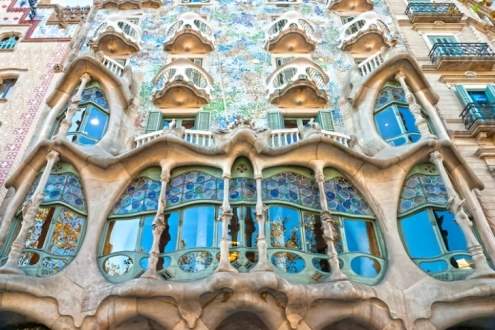
Charles Ashby’s guild and school of handicraft helped revolutionized the design in Britain, their effects alongside the political backdrops of the arts and crafts movement the time, were powerfully felt throughout Europe. (Bedoyere, 2005) (Philinthecircle, 2014)
It was and is a decorative style of art that thrived in Europe and the United States. Art Nouveau’s use of a long, sinuous, organic lined design and was seen often in architecture, interior design, jewellery and illustration. It was a thoughtful attempt to generate a new style, free of the derivative historicism that subjugated the majority of the 19th-century art and design. (Mackingtosh, 1999) (Bedoyere, 2005)
Vincent Van Gogh
Vincent van Gogh was the eldest of six, the third of three siblings to be involved in art. He was inspired in by his country surroundings and his mother who was a skilled amateur artist. His flare for art became more predominant in secondary school. Between 1869 and 1876, he was an apprentice at Goupil and Company’s chain of art galleries and achieved an excellent standard, being promoted to their London branch. In the Years of 1880 to 1886, he became a established artist, he adopted the colours and the brushwork of the impressionists but he strayed away from this approach by working and being inspired by the artist Pissarro, catching on to the movements in Paris making his own personal statements in his pieces. He had become one of the leading figures in post impressionism a new alterative direction. His work inspired the artists of the 20th century, but sadly he was never able to fully enjoy any of his success. His work is nearly always portraying a coarse beauty and bold colours and emotional honesty. He unfortunately suffered from mental disorders and died at the young age of 37 taking his own life . (Hardy, 2003) (Forrest, 2002) (Liddell, 2001)
Art deco
Art Deco design was modern, representing the majestic time of a new style in a continuing in the modern world. It functioned as a trademark, of femininity during a time when women were stereotyped to be the main consumers of the house hold, Art Deco-inspired consumerism helped shape the image of femininity that would dominate the American imagination for decades to come. In films of the middle and late 1920’s the Jazz Age, with flapper girls, extravagant parties. It truly was a glamorous time a era that embraced technology. This is a key to separating the factors between Art Deco and the Art Nouveou.
(Fischer, 2003) (Pacitti, 2014)
Table of Figures
Figure 1 Victorian make up 1 https://vintagedancer.com/victorian/victorian-makeup-beauty-guide/
Figure 4 Victorian make up 2 https://www.pinterest.co.uk/pin/384143043201489720/?lp=true
Figure 10 Icons https://gaskellsociety.co.uk/elizabeth-gaskell/
Figure 11 Elizabeth Garrett Anderson
Figure 19 https://www.rct.uk/collection/407143/the-inauguration-of-the-great-exhibition-1-may-1851
Figure 20 https://en.wikipedia.org/wiki/Protector_lock#/media/File:Crystal_Palace.PNG
Bibliography
-
Augustyn, A., 2019. Art Nouveau Artistic style. [Online]
Available at: https://www.britannica.com/art/Art-Nouveau
[Accessed 2.1.2019 January 2019]. - Barringer, A., Smith, J. & Rosenfeld, T., 2012. Pre-Raphaelites: Victorian Avant-garde. First ed. London: Tate Britan.
-
BBC, 2014. Elizabeth Gaskell (1810 – 1865). [Online]
Available at: http://www.bbc.co.uk/history/historic_figures/gaskell_elizabeth.shtml
[Accessed 2.1.2019 January 2019]. -
Beautiful with Brains, 2010. beauty in the victorian age. [Online]
Available at: http://www.beautifulwithbrains.com/beautyinthevictorianage
[Accessed 5 11 2018]. - Bedoyere, C. D. L., 2005. Art Nevoeau. 1 ed. Fullam: Flame Tree.
- Boardman, M. B. K., 2001. Victorian Womens Magazines: An Anthology. 1 ed. Manchester: Manchester university press.
- Downing, S. J., 2012. Beauty and Cosmetics. 1 ed. New York: Shire publications .
- Fischer, L., 2003. Designing Women: Cinema, Art Deco, and the Female Form (Film and Culture Series). 1 ed. Coliumbia: Jhon Felton.
- Fleming, R., 2012. Early victorian make up. Kate Tattersall Adventures, p. 1.
- Forrest, A., 2002. Van Gogh A beginners Guide. 1 ed. London: British Libary.
-
Glancey, J., 1994. The indpendent. [Online]
Available at: https://www.independent.co.uk/life-style/in-all-his-works-most-wonderful-augustus-pugins-passion-for-gothic-architecture-dominated-the-face-1422553.html
[Accessed third December 2018]. - Grange, 2002. Arts And Craft Movment. In: Arts and Craft movment. Rochester: Grange Books, p. 192.
-
H&MUA Team, 2012. Hair and Makeup Artist Handbook. [Online]
Available at: http://hair-and-makeup-artist.com/womens-edwardian-hairstyles/
[Accessed 3.1.2019 January 2019]. - Hardy, W., 2003. History & Techniques Of The Great Masters Van Gogh. 1 ed. Hertfordshire: Eagle Editions ltd.
- Komar, M., 2016. Your Beauty Routine Today Versus How It Would Look In The 1800s Will Show You How Twisted Things Used To Be. Your Beauty Routine Today Versus How It Would Look In The 1800s Will Show You How Twisted Things Used To Be.
- LeBourdais, P., 2016. What Is Art Nouveau?. What Is Art Nouveau?.
-
Liddell, S., 2001. The tragic genius of Vincent van Gogh. [Online]
Available at: https://stephenliddell.co.uk/2014/03/01/the-tragic-genius-of-vincent-van-gogh/
[Accessed 3.1.2019 January 2019]. - Mackingtosh, A., 1999. Modern art Impressionism to Post modernism. 2 ed. London: Thames and Hudson.
- Manet, J., 2017. Growing Up with the Impressionists: The The Diary of Junie Manet. 1 ed. London. New York: I.B Tuarius&co LTD.
- Matthews, M., 2008. A victorian ladies guide to fashion and beauty. First ed. Barnsley: Pen and Swords .
- North & South. 2004. [Film] Directed by Brian Percival. UK: BBC.
- Pacitti, M., 2014. All about art deco. Art Deco, p. 2.
-
Pettinger, T., 2014. Biography of Queen Victoria. [Online]
Available at: https://www.biographyonline.net/royalty/queen-victoria.html
[Accessed 27 november 2018]. - Philinthecircle, 2014. Art Nouveau – Overview. [Sound Recording] (Philinthecircle).
-
Picard, L., 2009. The Great Exhibition. [Online]
Available at: https://www.bl.uk/victorian-britain/articles/the-great-exhibition
[Accessed november 2018]. -
Richman-Abdou, K., 2017. Exploring the Vision and Diverse Styles of Post-Impressionism Pioneers. [Online]
Available at: https://mymodernmet.com/post-impressionism/
[Accessed 2.1.2019 January 2019]. -
Royal Albert Hall, 2018. The history of fashion 1840-1890. [Online]
Available at: www.vam.ac.uk
[Accessed 25.11.2018 November 2018]. -
TATE, 2018. tate.org. [Online]
Available at: https://www.tate.org.uk/art/art-terms/p/pre-raphaelite
[Accessed 10 december 2018]. - Victoria. 2016. [Film] Directed by Oliver Blackburn. Tom Vaughan. Sandra Goldbacher .Lisa James Larsson .Daniel O’Hara. UK: ITV.
- Victoria. 2016. [Film] Directed by Oliver Blackburn. UK: ITV.
-
Vintage Fashion Guild, 2018. Vintage fashion Guild. [Online]
Available at: https://vintagefashionguild.org/1900s/
[Accessed 25.11.2018 november 2018]. - Wells, N., n.d. s.l.:s.n.
Cite This Work
To export a reference to this article please select a referencing stye below:
Related Services
View allDMCA / Removal Request
If you are the original writer of this essay and no longer wish to have your work published on UKEssays.com then please click the following link to email our support team:
Request essay removal